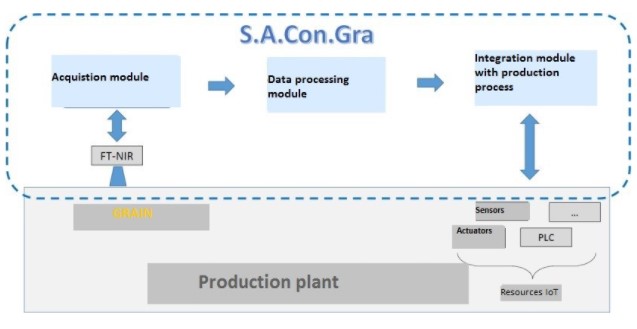Automatic on-line grain control system
Innovative technological solutions capable of carrying out grain screening, ensuring the quality, traceability and safety of raw material
| Business | Start date | Prime Contractor | Clients |
|---|---|---|---|
| Industry | 2021 |
RAM Elettronica Srl | POR Puglia ERDF 2014-2020, Sub Action 1.4B |
Challenge
The structure and composition of the grain are decisive factors for its use in industrial processes such as milling, bread making, pasta making, malting and brewing. For this reason, it is necessary to find innovative technological solutions capable of identifying the quality of raw material used for subsequent industrial processing, while ensuring its traceability and food safety aspects.
The aim of the project is therefore to provide a nondestructive, fast system, able to carry out grain screening to identify their best-intended use.
Approach
Thanks to a funding of the Apulia Region, as part as POR Puglia ERDF 2014-2020, Sub Action 1.4B, RAM Elettronica s.r.l. (based in Andria, Apulia) as project leader, with a team of researches, experts in Food Technology, from the University of Foggia, is experimenting with the prototyping of an automatic online grain control system.
The “Automatic Grain Control System” project (shortened in S.A.Con.Gra) aims to offer a solution that meets the needs of the customers, with particular reference to industrial automation increasingly in line with IoT paradigm, a key driver of Industry 4.0.
Our team will contribute the project with the implementation of the software for the grain control system, acquiring and analysing the data from the measuring instrument and integrating the system into the production facility.
Conclusion
The proposed solution is based on the FT-NIR spectroscopy, which will allow to determine directly on the grain the visco-elastographic parameters of the flour that may affect the finished product properties.
The NIR vibrational spectroscopy turned out to be the winning key of the planning quality because, through the absorption spectra related to the ties of functional groups present in the grain protein structure, it allows:
- to evaluate the protein composition and the secondary structure of gluten proteins, that is possibile to combine with the finished product functionality both from a technological and organoleptic point of view
- to measure the grain’s aptitude for pastification.
